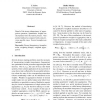Free Online Productivity Tools
i2Speak
i2Symbol
i2OCR
iTex2Img
iWeb2Print
iWeb2Shot
i2Type
iPdf2Split
iPdf2Merge
i2Bopomofo
i2Arabic
i2Style
i2Image
i2PDF
iLatex2Rtf
Sci2ools
EUSFLAT
2003
2003
Fusion with quantitative weights
Based of the strong idempotency of aggregation operators, quantitative weights are incorporated into the fusion process. Our general method is compared with some previous specific cases. Several examples are included.
| Added | 31 Oct 2010 |
| Updated | 31 Oct 2010 |
| Type | Conference |
| Year | 2003 |
| Where | EUSFLAT |
| Authors | Tomasa Calvo, Radko Mesiar |
Comments (0)

